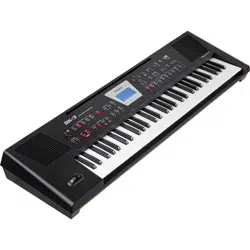Loading ...
Loading ...
Loading ...

One Touch Edit
53
Language
This parameter allows you to choose the character set to be used
for the following:
• Lyrics display (for les that contain lyrics)
• “Search” functions. See”Using the ‘Search’ Function to Locate Songs
or Rhythms” (p. 32).
• “Rename” functions. See “Rename a Performance List” (p. 38).
Parameter Setting
Language Latin, Cyrillic, East Europe
Save Global
This function allows you to save all “Global” parameter settings to
ensure that they are loaded automatically each time you switch the
BK-3 on.
You can select this function using [MENU] button “Global”
“Save Global”.
1. Use the [INC] or [DEC] button to select “YES”, then press
the [ENTER] button to dene the current settings as the
default state.
The display shows a conrmation message.
If you don’t want to dene the current “Global” settings as the
default state, use the [INC] or [DEC] button to select “NO”, then press
the [ENTER] button. The BK-3 then returns to the “Performance
Edit” page.
One Touch Edit
See “Programming Your Own ONE TOUCH Settings (One Touch Edit)” (p.
27).
Makeup Tools (rhythms and SMF)
These functions allow you to actually edit the selected rhythm or SMF
song (Standard MIDI File) without paying too much attention to the
underlying parameters.
NOTE
The “Rhythm Makeup Tools” and “SMF Makeup Tools” functions
cannot be used to edit Standard MIDI Files that use the XG
format.
Using the Makeup Tools
1. Select the rhythm or SMF song you wish to modify on
the connected USB memory. See “Selecting Rhythms” (p.
24) and “Selecting a Song or Rhythm on a USB Memory”
(p. 28).
2. Press the [START/STOP] / [ */, ] button to start playback of
the song or rhythm.
This allows you to listen to the song or rhythm before you start
editing it.
Press the [START/STOP] / [ */, ] button again to halt playback.
NOTE
If you selected a rhythm or SMF song on the connected USB
memory, press and hold the [EXIT] button to return to the main
page.
3. Press the [MENU] button.
4. Use the [UP] or [DOWN] button to select “Makeup Tools”,
then press the [ENTER] button.
If you selected a rhythm in step (1), the display changes to:
If you selected an SMF song in step (1), the display changes to:
This menu allows you to select the following entries:
Menu Option Explanation
Common
Select this entry to change common parameters that
aect the rhythm or song as a whole, like the reverb or
chorus eect, the tempo, etc.
Instrument
Select this entry to change the instruments used in the
rhythm or song and their parameters (p. 54).
Freeze Data
Select this entry to “burn” your new settings into the
le. Doing so will allow you to use your new version
with any sequencer (software) or compatible Roland
backing instrument (p. 57).
Save
Select this entry to save your song or rhythm with the
“Makeup Tools” settings you have made (p. 57).
Common
To edit the Common parameters, use [MENU] button “Makeup
Tools” “Common”.
The “Common” parameters on this page apply to the entire song or
rhythm.
1. Use the [UP] or [DOWN] button to select the desired
“Common” parameter.
2. Use the [INC] or [DEC] button to change the parameter
value.
3. If you are satised with your changes and wish to
preserve them, save your rhythm/ song to the USB
memory.
See “Saving Your New Rhythm or Song (SMF) Version in USB
Memory” (p. 57).
NOTE
The changes you make using the procedure described above
can be “burned” into the rhythm/song le using the “Freeze
Data” command (p. 57). Doing so will allow you to hear those
Loading ...
Loading ...
Loading ...
